Aylesbury Vale Area Design Supplementary Planning Document
5. Site layout, streets and spaces
5.1 Inclusive and sustainable design
Principle DES18: Design for everyone and look to the future
The future-proofing of a design is integral to the implementation and long-term success of any development. Applicants therefore need to take the changing climate, and the conditions it will bring with it, into account. This could be through, the selection of plant species for an environment two degrees warmer in the Vale, providing shade or through pest and disease resilient cultivars. See Principle DES46: Minimise environmental impact through energy efficient and sustainable design.
Proposals should install infrastructure that looks to the future including electric charging points for cars (refer to Principle DES27) and consider new ways of doing things for instance introducing car club spaces.
Design should be compliant with the Disability Discrimination Act 1995 and Equality Act 2010, or any subsequent legislation, therefore enabling everyone to use the space and participate in community activities equally, irrespective of their age, gender, ethnicity, religion and mobility and thereby meet the needs of people using wheelchairs, those with mobility impairments or with pushchairs.
Spaces should be designed to encourage social interactions which cross demographic groupings and should not be intended for one particular group.
Development should be designed to allow safe and easy use by all, to limit both physical and perceived barriers which will allow for independent use. This can be achieved through appropriate choices in street furniture and careful design of paving, parking, public transport provisions, lighting and signage.
Reason
5.1.1 Buildings and public spaces should be designed so that they are accessible and inclusive to all users.
5.1.2 An inclusive approach to design enables everyone to participate equally, confidently and independently in everyday activities. The principles of inclusivedesign, identified by the Design Council CABE, should inform development proposals.
5.1.3 The five principles are:
- Place people at the heart of the design process;
- Acknowledge diversity and difference;
- Offer choice where a single design solution cannot accommodate all users;
- Provide for flexibility in use; and
- Provide buildings and environments that are convenient and enjoyable to use for everyone.

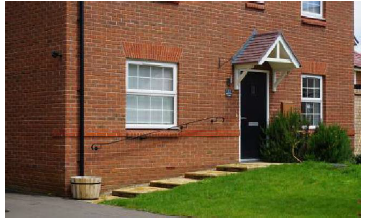
5.1.4 When designing streets and spaces applicants should follow the healthy streets approach which focuses on the human experience and embeds public health in the design process (refer to Principle DES26).
5.2 Urban structure and sense of place
Principle DES19:Deliveraclearstructure of streets and spaces that is easy to understand and move through
Applicants should promote an urban structure to their development that is easy to understand, where there is a clear street hierarchy and network of open spaces and that is reflective of settlement characteristics and form.
Development should create a grid network of streets and perimeter blocks which may be regular or irregular in form. The perimeter block is most appropriate for achieving successful development as it:
- Optimises connections to surrounding areas;
- Provides a clear distinction between public and private spaces;
- Enhances permeability and legibility;
- Generates building frontages that face the street and thereby increases natural surveillance and activity on the street;
- Creates secure and private rear gardens and elevations;
- Can work at any scale or location; and
- Ensures attractive street frontages.
The block size and shape will vary according to the density of development, location within the Vale and mix of uses. The blocks should take into account natural features, orientation and topography.

Figure 5.1: INDICATIVE SITE CONCEPT PLAN 8 - Delivering a clear structure of streets and spaces
Reason
5.2.1 The layout of all existing towns and cities can be simplified into a grid of blocks and plots. The blocks within the grid may be regular shaped squares or rectangles (providing a regular grid), as found in many new towns, or it may be more irregular (providing a more irregular grid), as found in historic towns and villages.
5.2.2 Blocks will vary in size and shape and should be broadly reflective of the sites settlement context whilst respecting natural features, orientation and topography, and providing sufficient back to back distances to provide residential amenity.
5.2.3 In general, blocks between 50 - 120 metres in length provide a permeable network for both pedestrians and vehicles.

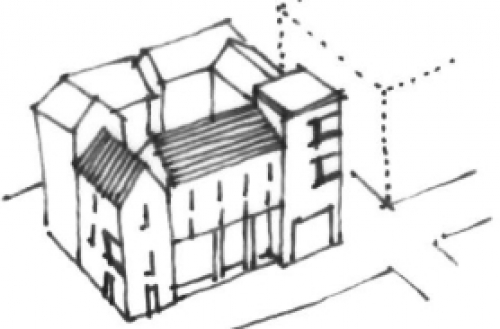

(From Left to Right) Figure 5.6: Higher density, urban blocks are suitable in more urban locations Figure 5.7: Lower density, blocks are more suitable in rural locations

Properties expose their rear boundaries to the street providing no animation or overlooking of the streetspace and contrary to secured by design principles
Principle DES20: Provide enclosure and positive frontage to streets
New development should normally provide strong street enclosure and continuous frontages that provide coherent building lines with the corners of blocks emphasised. Buildings should be arranged with public areas to the front and private areas to the rear and so that buildings overlook and provide active frontages and natural surveillance to streets and spaces.
Proposals should provide a sense of enclosure appropriate to the role of the street within the street hierarchy and in order to achieve a human scale. This will help to create a sense of place and reinforce the legibility of the development.
Streets and spaces that do not provide adequate enclosure or are dominated by roads or parking will not be acceptable.
Reason
5.2.4 The siting of buildings in relation to the street can have a significant effect on the success of a development. The most successful layouts have 'public fronts and private backs'. These streets have clearly defined 'edges' and allow for natural surveillance minimising opportunities for crime and escape. It also encourages greater social interaction between neighbours.
5.2.5 Within established urban areas where there is an existing building line, this should inform the design and layout of a new development with new buildings following the established line.

Figure 5.8: New buildings in a street should follow the established building line

Figure 5.9: Perimeter block layout ensuring a clear definition of front and backs and a strong building line to the street; Figure 5.10: Streets should not mix fronts and backs


Left: Figure 5.11: Road dominated: lack of enclosure; Right: Figure 5.12: Place focused: enclosure provided by buildings creates a better street environment
5.2.6 The distance that the building line is set back from the street, together with the height of the buildings determines the level of enclosure that is experienced within the street.
5.2.7 Enclosure may be building dominated or landscape dominated. Trees, hedges and walls can contribute towards creating a sense of enclosure.
5.2.8 Enclosure also creates different conditions. In the case of a square or courtyard, enclosure helps to create a 'static' environment; in a street, where movement is the main characteristic, enclosure helps to create a 'dynamic' environment.
5.2.9 Enclosure is normally calculated by the ratio of the height of the buildings to the width of the street or space.
5.2.10 It is usually appropriate to set buildings back from the public realm to provide a private defensible space. Even the smallest setback can help privacy and security.
5.2.11 The setback distance should normally be between one and three metres with applicants balancing the need for enclosure, site optimisation and privacy. However where larger front gardens are a strong characteristic of an area a greater set back distance may also be appropriate.
5.2.12 Applicants should refer to their Character Study (Chapter 3) to inform the level of enclosure appropriate for their site. As a rough guideline, a ratio of between 1:1.5 to 1:3 (height:width) is likely to be appropriate depending on the hierarchy of street or public space (Refer to Urban Design Compendium). Applicants must seek to maintain or enhance the characteristics of the context within which their site is proposed. The space between buildings should be well defined but not oppressive.
5.2.13 A significant challenge for larger residential developments is to provide a form of development that is appropriate to people rather than cars. When buildings are set back from the street, road space and parking areas should not dominate the street scene.


5.2.14 Human-scaled streets can normally be achieved through increased levels of enclosure (typical of historic developments that pre-date the motor car) by setting buildings close to the street edge (responding to pedestrian rather than car movements).
5.2.15 Creating a sense of enclosure on a main street through a development may require an increase in building height to balance the increased building to building distance.
5.3 Mix of uses
Principle DES21: Promote a mix of uses within larger schemes to provide services to meet local needs, conveniently located where they are most accessible
Larger scale development proposals will normally require a range of local services and facilities to be incorporated. The viability and vitality of these of these uses will depend on the existing and proposed catchment.
The location of mixed-use centres and neighbourhood hubs is key to their viability and long-term success.
Mixed-use centres should:
- Be conveniently located at the intersection of well-connected streets;
- Be highly visible;
- Cluster a mix of facilities around an appropriately scaled high quality public realm or public space as a central focus with buildings serving to enclose the space;
- Provide higher floor to ceiling heights at ground floor level to accommodate a variety of uses and allow for future adaption;
- Include residential development within the mix above non-residential uses to ensure activity and surveillance throughout the day and night;
- Wrap and conceal the non-active parts of larger non-residential buildings (such as supermarkets or leisure buildings) within blocks with a Higher density Residential hinterland perimeter of active development;
- Locate servicing areas where they do not visually dominate the streetscene and avoid dead frontage overlooking the public realm;
- • Be accessible for all users, with particular consideration given to how the elderly and disabled will access and use the centre;
- • Provide short stay / visitor and disabled car parking spaces and secure cycle parking integrated into the streetscape or landscape design with convenient access to capitalise on passing trade. The appropriate number, location and layout will depend on the local context. Electric vehicle charging points should also be provided where appropriate; and
- • Be accessible by pedestrian and cycle users and be served by a frequent bus route with bus stops conveniently located and well-overlooked and where they are accessible to everyone and attractive to use to encourage patronage.

Reason
5.3.1 Successful communities require a full range of local facilities and services conveniently located and integrated within a settlement and that are connected by safe and pleasant streets.
5.3.2 A mixed-use development helps to support activity and surveillance throughout the day and night contributing to a greater feeling of safety.

Figure 5.14: INDICATIVE SITE CONCEPT PLAN 9 - Provide a mix of uses


Left: The Exchange in Aylesbury town centre provides residential uses over restaurants and overlooks a new high quality public space; Right: Local centre at Fairford Leys, Aylesbury provides local services
Principle DES22: Provide a mix of residential typologies within residential schemes to create mixed communities and ensure these are adaptable to change
Applicants should deliver development that provides a mix of dwelling types (including apartments and terraced homes) and tenures to meet local need as identified in Local Plan Policies H1 Affordable housing, H6a: Housing Mix, H6b: Housing for older people, H6c: Accessible and adaptable dwellings and H5; Self / custom build housing. Applicants should agree this mix through discussion with the council.
Affordable housing should be distributed appropriately throughout the site, and have the same external appearance and quality of finishes as private housing. There are nevertheless architectural benefits of grouping identical housing types as it gives street frontages underlying rhythm and order. Grouping housing types also aids diversity across the development.
Buildings should be designed so that they can be altered internally or externally over time without the need for demolition or rebuilding as needs change. Very narrow fronted buildings are unlikely to be easily altered or extended. By building flexible internal space, rooms can be adapted to different uses depending on family requirements.
Buildings should be designed to maximise the potential for lifetime use. Refer to Lifetime homes guidance for further details.
New residential developments should address the needs of people with disabilities by complying with Building Regulations. This requires reasonable provision to be made for people with disabilities to gain access to and to use buildings.
Wheelchair accessible homes should be designed in accordance with recognised guidance such as Wheelchair Housing Design Guide (Habinteg, 2006). These homes should be positioned in highly accessible locations.
For proposals of 100 dwellings and above the council expects applicants to identify a percentage of plots for sale to self-build / custom builders in accordance with VALP Policy H5. These plots must be integrated into the applicants scheme and the council will not accept proposals that allocate these plots to the least favourable parts of a site.

Custom housing can deliver greater variety and choice
Reason
5.3.3 People have differing requirements of their home, depending on cultural needs, economics, health requirements and age. The housing available should reflect this diversity and allow people to up and downsize as their life changes or to adapt their property to respond to changing needs.
5.3.4 Development that is capable of responding to changing social, technological and economic conditions is more likely to be successful and ultimately more sustainable.
5.4 Density, scale and massing
Principle DES23: Ensure that development density and the scale and massing of proposed buildings responds to the existing and emerging character and context of an area
New development should generally respond to the scale, massing and grain of adjacent areas and the settlement context within which it is located.
In some parts of Aylesbury Vale, notably in Aylesbury Garden Town, but also in other towns in the area, there may be an opportunity to deliver a new development character provided this is part of a comprehensive vision, establishes sense of place and does not impact on the sensitive townscape or landscape assets of an area.
For larger development proposals a range of densities, building types and forms are likely to be appropriate.
Increased densities should be focused:
- Around key movement intersections;
- Along strategic routes;
- Overlooking public spaces; and
- Within town, village and local centres.
This varied density profile adds character and interest, supports local facilities and public transport and can provide the building mass to create strong framing of public spaces.
Within larger new residential urban extensions building height and scale in the most accessible and central areas may be up to four storeys. This will deliver higher density development, diversify the mix of residential typologies and create a focus for the new development.
Development that is of a greater scale, height and massing than the existing context can have both adverse local impacts in respect of daylighting, overshadowing, views and microclimate and adverse visual impacts from further afield particularly if a proposal is on elevated land.
Any development that promotes a scale, height and massing that is greater than the existing context must therefore demonstrate that:
- It does not cause unacceptable impacts on adjacent properties in respect of daylighting, sunlighting and overlooking; and
- That it does not adversely impact on views of the wider townscape.
Consideration must also be given to the provision of car parking within higher density schemes and applicants will need to promote solutions that do not adversely impact on the quality of the streets and spaces. In some locations basement car parking or car free developments should be considered
Reason
5.4.1 The scale and massing of development must be appropriate for the site in which it is promoted.
5.4.2 Whilst higher density developments within town centres is generally welcomed and will help to deliver much needed homes and employment space in the most sustainable places, consideration must be given to:
- The scale of buildings
This should normally relate to the immediate and wider context; - The uses at ground floor level
On the main commercial streets within town centres, uses should generally be non-residential and provide an ‘active’ frontage that animates the street (shops, café, restaurant, office, community use for instance). Blank frontages will not be acceptable; - The interface of buildings with the street
Where active uses are promoted buildings should front directly onto the public realm with the building positioned to conform with an established building line. Where residential uses are promoted at ground floor level, buildings should be set back from the street and appropriate privacy created through boundary and interface treatments and planting (refer to Principle DES38); and - The location of car parking
This should not dominate or adversely impact on the quality of the street environment.

Figure 5.15: INDICATIVE SITE CONCEPT PLAN 10 Increasing density in relation to accessibility
5.4.3 Within larger urban extensions, including within Aylesbury Garden Town, the character and form of the different parts of the development should vary in order to enhance legibility and sense of place and deliver a variety of residential typologies to create a more balanced community. Refer also to Chapter 7.
5.4.4 This variation of development character across a site will deliver a range of residential densities with higher density development in the more accessible locations and lower density development in the more peripheral areas.
5.4.5 More compact development that creates a stronger sense of street enclosure should be promoted along main streets and around local / neighbourhood centres. This may be delivered through a combination of greater height, vertically articulated frontages and terracing of properties to deliver a more continuous street frontage with underlying rhythm and order. Care must however be given to air quality issues where more compact development prevents air circulating and pollution dispersing effectively.



5.5 Legibility and image
Principle DES24: Use markers, landmarks, vistas and street hierarchy to aid legibility
Development should seek to enhance legibility through a layout that responds to existing landscape features (including trees), structures or buildings or through the careful location of new features or buildings to act as markers or landmarks. For larger schemes development should be laid out with a clear street hierarchy that allows users to easily distinguish main streets from secondary and minor routes.
Reason
5.5.1 Landscape features including trees, structures or special buildings can help to add distinctiveness to a place and act as visual cues to aid legibility and understanding.
5.5.2 Streets that create a varied sequence of spaces and vistas aligned with focal buildings can be more rewarding and contribute to the understanding of a place. This can be achieved through:
- A curve or kink in the street;
- Off-setting the street network and terminating the view on a building;
- Creating a pinch point; and/or
- Locating a taller building to terminate an axial view.

Figure 5.16: INDICATIVE SITE CONCEPT PLAN 11 - Enhancing legibility
5.5.3 Buildings marking an important place or location in the townscape may be a little taller than the surrounding context but this increase in height must be proportionate to the role that they play in the streetscape.
Principle DES25: Create a positive development edge
Applicants should normally design their proposals with building frontages facing site boundaries served by new access roads that run adjacent to the site edge for the following reasons:
- To avoid back fences abutting the countryside;
- To fully reveal existing trees and hedgerows to the public realm; and
- To safeguard the future of existing trees / tree belts / hedgerows by incorporating them outside private gardens while also avoiding overshadowing of rear gardens.
Development should be sensitively designed so that it avoids imposing upon the rural edge and existing roads that are characterised by their hedgerows and tree belt. This may require additional boundary planting. At the rural edge lower density development will normally be necessary.
Reason
5.5.4 The interface between a settlement and the countryside should provide a positive transition between the two environments. On the one hand there is a need for a clear definition of where the settlement starts that provides a welcoming edge and sense of arrival. On the other hand it will often be necessary to use planting to help to soften the impact of new development on the surroundings.

Left: The edges of development should respond positively to the existing landscape and avoid close boarded fences abutting the countryside; Right: Homes at the former Princess Mary's hospital in Wendover have a positive relationship with the adjacent woodland
5.5.5 Properties should not back onto the settlement edge and the edge should not be defined by rear garden fences. This can create security problems and over time the quality of the environment can become degraded as fences are replaced or fall into disrepair. When viewed from the countryside this creates an unresolved and untidy edge that diminishes the quality of the environment.

Left: Development presents an unacceptable relationship with the wider countryside; Right: Figure 5.17 - Development provides a positive development edge
5.6 Pedestrian friendly streets / street hierarchy
Principle DES26: Provide attractive streets and spaces defined by buildings rather than the highway, that encourage low speeds and that are safe to use by everyone
Streets should be designed as social spaces with the needs of pedestrians, cyclists and public transport users put above the needs of the motorist.
Within larger developments a clear street hierarchy should be promoted with the principal vehicular routes integrated within the structure of development as main streets or boulevards with tree lined building frontages.
Streets should be well defined and enclosed by building frontages normally in combination with a line of trees and appropriate planting. Refer also to Principle DES35.
Streets should encourage pedestrian movement through appropriate pavement widths, avoiding unnecessary barriers or clutter and providing places for pedestrians to rest, gather and socialise.
Residential streets should be designed to a maximum speed of 20 miles per hour. Traffic calming measures should be integrated within the design of the streets (and not as engineered solutions imposed afterwards) to encourage drivers to drive with care and caution.

Streets with generous footways, tree planting and good overlooking from adjacent buildings feel safer to use
Reason
5.6.1 Streets should be designed as public spaces that serve many functions, not only the circulation of traffic, but also walking, cycling, play and places for social interaction. Streets should provide shade and shelter, make people feel safe and relaxed, and provide interest and visual stimulus. As such the design of streets should not be led by engineering solutions
or dominated the car but instead have a strong emphasis on place-making and pedestrian movement.
5.6.2 New developments should be designed to encourage sustainable transport modes and healthy lifestyles and to reduce reliance on the car. This can have positive benefits on air quality and human health. To achieve this it is important that the street environment is attractive to pedestrians and cyclists and feels safe.

Figure 5.18: Design streets as social spaces
5.6.3 The design of streets should follow the Healthy Streets Approach. This uses a number of indicators as measures that improve health, reduce inequalities and encourage people to walk and cycle. The design of streets should:
- Be open to pedestrians from all walks of life;
- Provide infrastructure that is easy to cross;
- Offer shade and shelter;
- Offer places to stop and rest;
- Not be too noisy;
- Encourage people to walk, cycle or take public transport;
- Make people feel safe;
- Offer things to see and do;
- Allow people to feel relaxed; and
- Have clean air.
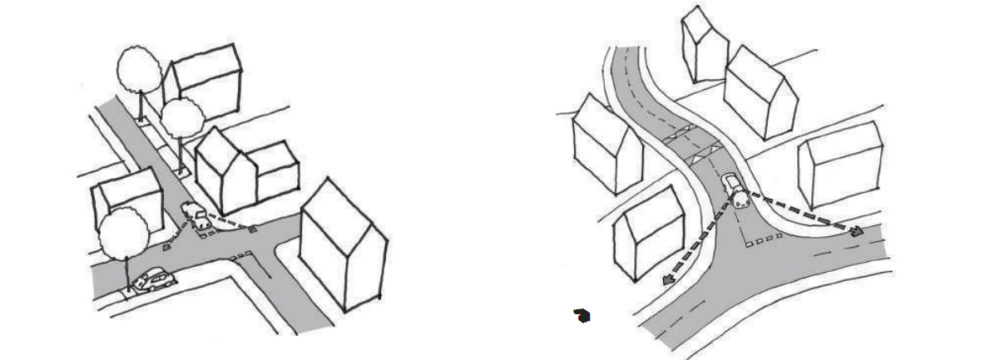
Left: Figure 5.19 - Frequent changes in direction, tight junctions and corner radii help to control traffic speeds; Right: Figure 5.20 - ‘Fast’ road with gentle bends and wide sight lines controlled by speed bumps gives mixed messages and can encourage speed
5.6.4 Creating roads which naturally reduce traffic speed plays a crucial role in road safety. Traffic calming should form part of the overall street design and should not be achieved through isolated measures like 'speed humps'. Designers should employ good design principles to ensure appropriate traffic speeds. Streets where 'place' functions dominate over 'movement' functions should be designed for a 20 mph speed limit.
5.6.5 Calming measures can help to create a more pedestrian friendly environment and may include:
- Varying the alignment of the vehicular route;
- Use of tight junction radii;
- Narrowing down the carriageway and the use of planting and build outs;
- The provision of designated on-street parking;
- Raised areas at junctions and nodal points; and
- Changes to surface colour/materials.
5.6.6 The use of shared surfaces will not be acceptable on through roads or roads serving more than 25 properties.
5.6.7 Other measures that make a street environment more attractive for pedestrians include:
- Provision of places to stop and rest;
- Areas of shade and shelter;
- Obstruction-free pavement edges to make road crossing easier; and
- Formal crossing points across busier roads, or at high-usage sites such as schools.
5.5.8 Unnecessary road markings, signage and other 'street clutter' should be minimised on streets where 'place' functions dominate over 'movement' functions. This helps to create better places, a better pedestrian environment and encourages safer driving.

Traffic calming measures should be integrated withinthe design of streets
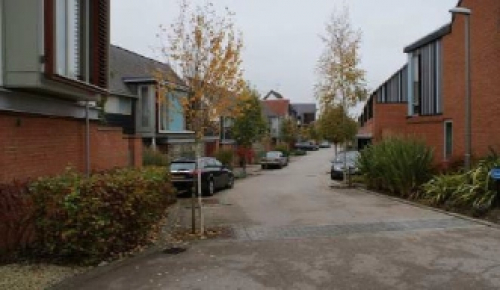
Successful shared surface street (serving local properties only) incorporating tree planting, soft landscaping and parking

Speedbumps as a traffic calming measure for newroads should be avoided.
5.7 Parking
Principle DES27: Integrate parking to meet needs and support attractive streets and spaces
The quality of the street environment should be a paramount consideration in designing parking spaces into the street. The inclusion of landscape and street trees as well as the provision for pedestrians should be integral to the design.
Applicants should prepare a comprehensive car parking strategy which contains a combination of appropriate parking solutions with a balance of on-street and off-street parking provided.
To achieve well defined streets with a good level of enclosure and avoid parking dominating streets, it will normally be necessary to accommodate under- croft or underground parking in the higher density areas with terraced housing and flats. Rear courts should generally be avoided and only provided where it is demonstrated that other solutions are not possible. They should be gated.
Larger parking courts/squares will normally be unacceptable unless they are designed as part of a well landscaped and ordered open space that contributes positively to the development.
On-street (right-angle and parallel parking) and front threshold parking will need to be well landscaped and incorporate generous safeguarding areas around trees and shrubs to protect them from pedestrian as well as vehicular movement, and provide for private defensible space at the front of dwellings.
For lower density areas with detached and semi- detached houses, parking should normally be discreetly accommodated to the side of dwellings. Off-street parking in front of houses should normally be avoided as this is likely to result in environments dominated by hard surfaces and generates greater face to face building distances leading to weaker street enclosure unless combined with taller building frontages.
Right-angle on-street parking is nevertheless sometimes acceptable providing it is positively designed as part of a comprehensive landscaped public realm and is limited to one part of a comprehensive parking strategy for the higher density areas.
Electric charging points should be provided in accordance with VALP policy T7.
Reason
5.7.1 Applicants should provide parking for both residents and visitors at an adequate level in response to the location of the site. The number of spaces must be determined using the councils parking standards or local standards where these are different (for example as identified within a Neighbourhood Plan).
5.7.2 The accommodation of parking represents a significant design challenge. If poorly designed
parking can have a significant negative impact on the appearance of the public realm.
5.7.3 A balanced approach should be taken to achieve convenient parking in close proximity to households whilst reducing the dominance of parking on the street scene. This will normally result in a range of parking solutions being incorporated. Areas of planting or street trees can help to reduce impacts (refer also to Principle DES35).
5.7.4 Non-allocated, shared parking (generally on street) is more efficient than designating parking to individual dwellings and this approach is encouraged to reduce parking numbers within development schemes especially in respect of terraced housing.
5.7.5 The suitability of parking solutions will vary depending on the location and nature of the proposal.
5.7.6 Parking standards, including the minimum dimensions of parking spaces and garages is set out in VALP Appendix B.

Figure 5.21: A good formal arrangement for a primary street that incorporates parallel parking with
regular tree planting within kerb build outs reducing its impact on the street space (Section)
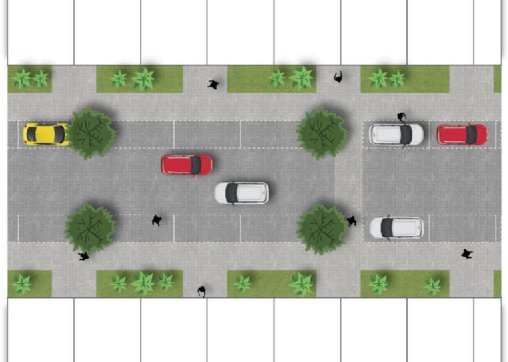
Figure 5.22: A good formal arrangement for a primary street that incorporates parallel parking with regular tree planting within kerb build outs reducing its impact on the street space (Plan)
On street parking
5.7.7 On-street parking for residents provides convenient spaces adjacent to properties and adds to the activity of the street and natural surveillance. On- street car parking also avoids vehicle crossovers on the pedestrian footway.
5.7.8 Lines of on-street parking spaces should be broken up into blocks of a maximum of 5 parking bays separated by kerb build-outs which may accommodate street trees, planting and pedestrian crossings.
5.7.9 Streets must be designed so that where on street parking is proposed there is adequate width to accommodate this parking without causing an obstruction to the highway (refer to VALP Appendix B).
5.7.10 On street parallel parking is a good solution for main streets where it can form part of a formal arrangement that aids legibility of the development. Parking must be designed with particular care to minimise visual impact, enable free movement of buses (where appropriate) and retain continuity of footways.
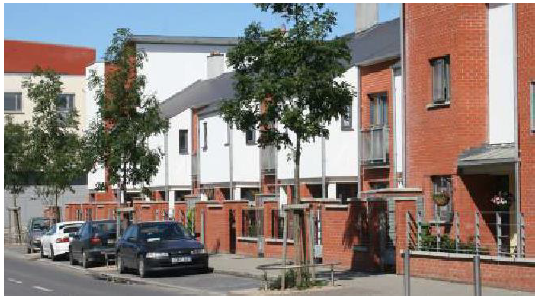
Street incorporating trees and parallel car parking
Parking Squares

5.7.11 Large unsightly expanses of hard surfacing or blacktop should be avoided. Parking squares may offer flexible use including providing space for events or markets and parking should normally be set out
in marked bays to ensure efficient use of space. Permeable paving is encouraged in these areas.
On plot parking
5.7.12 On plot parking can take a number of forms some of which contribute better to the quality of the street environment.

Within car ports or garages
5.7.13 This solution also allows buildings to be close to the street.Integral garages should be used sparingly as they reduce animation of the street at ground level.
Within undercrofts or basements
5.7.14 Appropriate for apartment schemes. This is generally an acceptable solution provided that a positive interface between the building and street is provided and entrances to car parking areas are designed to minimise intrusion on the street space.

To the side of dwellings
5.7.15 This allows buildings to be closer to the street space with car parking less visible from the street. Where adjacent plots adopt the same approach, care must betaken to avoid over wide gaps between dwellings that are dominated by walls, cars and hardstanding.

Left: Figure 5.23: Car parking spaces to the side of dwellings reduces the visual impact of cars on the street and allows buildings to be located closer to the back of kerb increasing the sense of enclosure. Right: Figure 5.24: Car parking spaces in front of dwellings results in wider streets and could deliver a streetscape dominated by parking. Planting and co-ordinated boundary treatments can reduce the visual impact
To the front of dwellings
.7.16 Whilst this is historically a popular model it necessitates wider streets, tends to have a considerable visual impact and can restrict informal surveillance of the street space. Parking to the front of dwellings should generally be avoided and where it is proposed its visual impact must be reduced through appropriate boundary treatments and landscape.
Rear parking courts
5.7.17 Applicants should avoid rear parking courts whenever possible. Where they are proposed they should be small scale, overlooked, gated and only serve properties that are located around the court. Entrances to parking courts should be carefully designed to create a semi-private appearance and courts should be secure.
5.8 Design for cyclists
Principle DES28: Plan for cyclists
Applicants should plan for walking and cycling when preparing their proposals in order to support the council's target of half of short local journeys being made by sustainable modes by 2050.
At a strategic level applicants must consider how their site may help to deliver the objectives of the new Aylesbury Local Cycling and Walking Infrastructure Plan, extend existing routes and integrate cycle routes with the cycle network in the town. This includes providing safe and direct routes between destinations in the Vale and adjacent areas.
All new cycle infrastructure should comply with guidance as set out in the Department of Transport Local Transport Note 1/20 Cycle Infrastructure Design (July 2020). This guidance is founded on best practice and on five core design principles; that networks and routes should be Coherent, Direct, Safe, Comfortable and Attractive and that they should be accessible for all.
Cycle parking and storage
Space should be made available within new development for parking of bicycles in accordance with the council's cycle parking standards.
Secure, covered cycle storage should be accommodated in a convenient location within each residential plot, within the rear garden, car port, garage or outbuilding.
Secure and convenient cycle storage for apartments should be provided within the main buildings, preferably close to main entrances. External communal stores are usually inappropriate as they are unlikely to offer convenient access for all residents and they are less secure. Large separate bicycle storage buildings that do not benefit from good natural surveillance should be avoided.
Dedicated visitor cycle parking should also be provided for apartments close to main entrances and well overlooked by habitable rooms with care being taken to ensure that such provision is carefully integrated into the design of the space.

Positive promotion of cycling in Aylesbury town centre
Reason
5.8.1 For cycling to become an attractive alternative to the car a network of attractive, safe and convenient cycling routes must be provided across the area.
5.8.2 It is also important that bicycles are readily accessible and can be securely stored. It is generally recognised that if secure cycle storage is conveniently located within individual dwellings or close to entrances, cycles are more likely to be used. This usually means locating cycle storage close to a buildings entrance at the ground floor level.
5.8.3 The type of storage will depend largely on the type of dwelling and the scale of the development. For houses a flexible storage space could be provided for bins, cycles and other items (e.g. e-scooters). Refer also to Principle DES31.
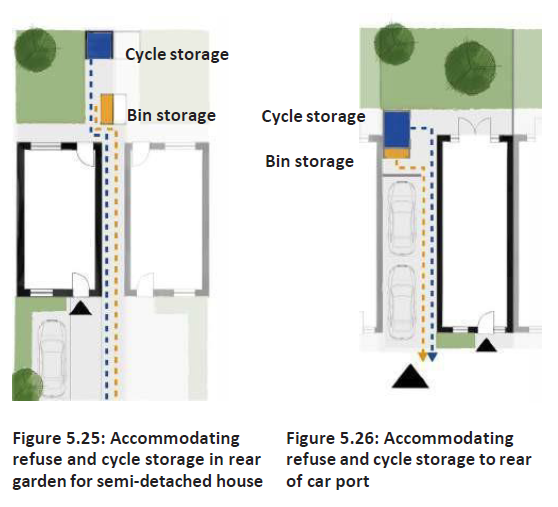

Case study: Aylesbury Gardenway
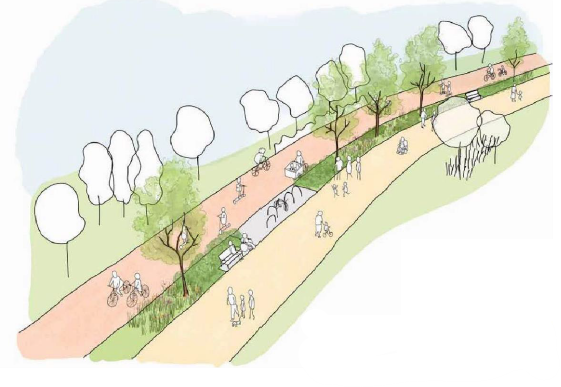
Aylesbury Gardenway orbital park is a proposed segregated route for walking, cycling and wheeling around the town, regardless of age, sustainable mode or ability. It will help set the standard for future cycleway provision in towns and villages throughout Buckinghamshire.
It is designed to make sustainable modes of transport more attractive, and preferable to using the car for short local journeys. It will help achieve the council’s target of half of short local journeys being made by sustainable mode by 2050.
Its design will encourage active lifestyles, help meet environmental targets and bring residents closer to nature. The Gardenway will raise the standard of crossing provision for people walking, cycling and wheeling. Crossing points will be designed to ensure everyone is able to safely and comfortably cross the road in accordance with the modal hierarchy required by VALP.
The Gardenway route will upgrade and improve junctions for walking, cycling and wheeling, applying high design standards and the latest best practice. Cycleway infrastructure on the Gardenway will comply with Local Transport Note 1/20 Cycle Infrastructure Design (July 2020).
5.9 Layout of commercial areas and infrastructure
Principle DES29: Deliver attractive and efficient employment areas and infrastructure
New employment areas or infrastructure should be accommodated sensitively to their context. Where they are adjacent or visible from the countryside, a generous landscape buffer will normally be needed to integrate the development sympathetically into the landscape context.
New employment areas should be accessible by non-vehicular modes and public transport, be well connected to the wider area and structured as a network of connected streets with development fronting those streets, wherever possible.
Development within new and existing employment areas should take a landscape led approach focusing investment in areas that will significantly contribute to the quality of the workplace environment.
Development should:
- Be laid out so that new buildings front onto streets with parking and servicing provided to the rear. A servicing strategy demonstrating safe access and egress should form part of the application;
- Establish a coherent and common design language throughout an employment area with a design code prepared for outline schemes;
- Provide quiet, open space with areas of shelter within an easily-accessible central location, where it can form a focus for the site;
- Enhance the street environment and establish a clear street hierarchy through planting of street trees and enhancements to footways and cycle routes; and
- Rationalise parking so that it has less impact on the street and break up larger expanses with planting and trees and provide charging points for electrical vehicles.
Existing employment areas are often located adjacent to residential areas and the interface between the two uses must be carefully considered to avoid overshadowing, loss of daylight or impacts on privacy (refer also to Principle DES41 and DES43).
Where employment areas or infrastructure are located in the countryside particular consideration must be given to visual impact. Commercial buildings or infrastructure by virtue of their size can have significant impact on their landscape setting.
Buildings or infrastructure should be sited where their impact is minimised, avoiding elevated ground and wherever possible utilising existing vegetation to act as a visual screen. Careful consideration must be given to materials, colours and finishes to reduce visibility. Generally muted colours and tones should be used and reflective materials avoided.
For larger employment buildings consideration should be given to sub-dividing structures and articulation of roofscape to reduce the apparent bulk and massing.

Office buildings set within green environment at Farnborough Business Park
Reason
5.9.1 Employment areas and infrastructure can have significant visual impact on the landscape or on the quality of place within settlements if not carefully planned.
5.9.2 Many of the employment areas in the area have evolved over time without a clear plan and present an environment that is unattractive for pedestrians and cyclists, that is dominated by car parking and service yards and that lacks trees and landscape.
5.9.3 There is often little amenity for employees and in many cases land is not used efficiently.

Buildings set within large areas of hardstanding should be avoided. Office building is set back from the street and the entrance is not obvious

Left: Figure 5.28 - Concept for employment area indicating primary route as boulevard, central space and key gateway buildings. Centre: Figure 5.29 - Layout plan showing indicative block layout with frontage and entrances overlooking the boulevard. Right: Figure 5.30 - Service yards and parking should be internalised within the perimeter block to reduce impact on the street environment
5.10 Refuse, storage and utilities
Principle DES30: Consider and allow for servicing, refuse collection and deliveries
The layout of development should be designed to facilitate service vehicles and refuse collections. The layout should be tested and tracked to ensure that this can be facilitated. A connected network of streets helps in this regard avoiding the need for large turning areas for servicing vehicles.
Consideration must be given to the storage and collection of bins at individual and communal properties, making sure residents are able to move bins easily to collection points , that bins are located conveniently for residents and that collection vehicles can access designated bin storage areas, minimising the risk of bins impacting negatively on the streetscape.
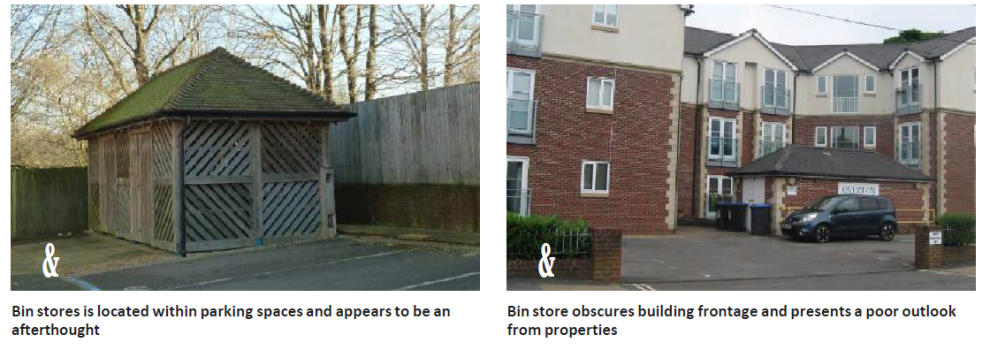
Reason
5.10.1 If not properly planned for refuse collection and storage can have a significant detrimental impact on the quality of the streetscape.
5.10.2 Applicants should refer to the AVDC Recycling and Waste Advice Note for Developers 2019.
5.10.3 In accordance with the recommendations in Manual for Streets residents should not be required to carry waste more than 30m (excluding any vertical distance) to the storage point; waste collection vehicles should be able to get to within 25m of the storage point and the gradient between the two should not exceed 1:12.
Principle DES31: Integrate refuse and recycling into the design of new development
Facilities for refuse and recycling storage should be:
- A suitable size to accommodate all the refuse and recycling containers to meet the needs of residents and be of a size acceptable to the refuse collection service;
- Located where they are neither visually obtrusive or where they obstruct passive surveillance of the street;
- Located where they will not be obstructed by car parking;
- Within secure and well ventilated areas; and
- Located so that they may be easily accessed from properties but where they will not cause nuisance through unpleasant odours or noise; and
- Coordinated with cycle storage (refer to Principle DES28 and Figures 5.25 to 5.27).
Principle DES32: Plan for and integrate sub-stations, utilities and pump stations into the design of new development
Enclosures for utility services including sub- stations and pump stations should be carefully designed and integrated into development so that they do not detract from the quality of streets and public spaces.
Utility runs should normally run under the footway or carriageway and the location should be carefully planned so that it does not impact on the potential for street tree planting.
 Reason
Reason
5.10.4 Consideration of the location of refuse storage and utilities apparatus must take place early in the design process as they can have considerable impact on the quality of environment within a development.
5.10.5 Applicants should refer to the AVDC Recycling and Waste Advice Note for Developers 2019. This provides details on the size and capacity of bins for residential and commercial properties and general requirements on their location (refer to para 5.10.2 for the link).
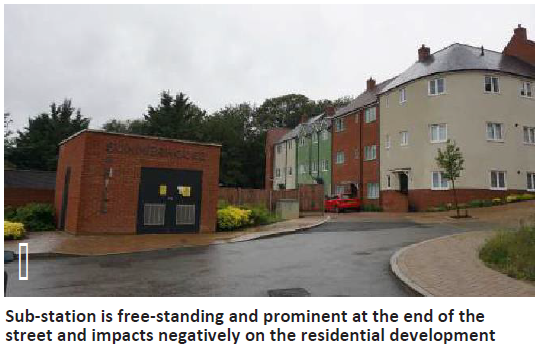
5.11 Open space and public realm
Principle DES33: Enhance the environment and sense of place through open spaces
Open space should play an essential role in structuring a development, forming part of the wider green infrastructure network. Open space should be multi-functional, creating places for people, nature and providing natural capital, ecosystem services and climate resilience. They should be accessible throughout the year.
Careful consideration needs to be given to the function and users of the space, alongside the balance between amounts of hard and soft landscape. Design and materials
for hard surfacing should be selected based on location, the anticipated use and level of activity and should incorporate the use of sustainable drainage systems to reduce pressure on the sewage system. Where furniture and equipment are provided, their design should be attractive, robust, durable, coordinated and appropriate to the context.
The open space network may comprise a variety of formal and informal spaces defined by buildings which front onto the open space to overlook and provide appropriate enclosure, enhancing natural surveillance. Open space provided alongside proposed residential development should include, but is not limited to: children's play areas, informal green space, wildlife and recreation areas, street trees, community orchards, woodland, parkland, playing pitches and pavilions.
The long-term management and maintenance of open space and public realm should be accounted for, with consideration given to the selection of materials, furniture and fixings, allowing for longevity and ongoing maintenance costs.
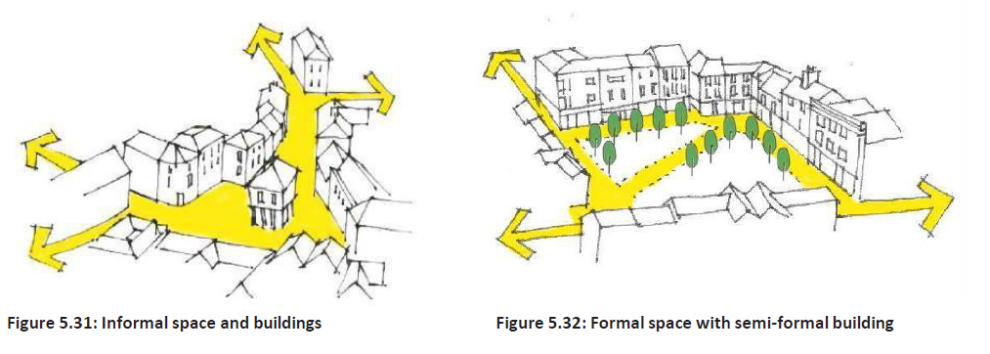
Reason
5.11.1 Open space creates an opportunity to reinforce a sense of place, as well as building stronger cohesion between new and existing settlement. They can be the focus for social interactions, play, recreation, travel and events; they should therefore be multi-functional and central to development.
5.11.2 Spaces should be designed to cater for specific uses designed in anticipation of the type and level of use and activity that may take place within them. Potential changes of use throughout the year should be considered, as well as how people are going to move through the space.
5.11.3 Previous studies into the local context and surrounding character of the site should be drawn upon (Chapter 3) when designing the open space, as well as responding to existing settlement needs. Applicants should refer to the AVDC Assessment of Open Space, Sports and Recreation Needs for Aylesbury Vale (and forthcoming strategies) for the required type and amount of open space and areas for sport, play and recreation.
5.11.4 Long-term management and maintenance of open spaces should be considered at an early stage in the design process.

Natural surveillance
5.11.5 It is important that spaces around buildings, foot and cycle path routes and open spaces are overlooked by the occupiers of buildings or bypassing pedestrians or motorists. Building entrances and windows looking out over pathways or other public areas will create an impression of observation and deter anti-social activity. Entrances to buildings should be visible from the street. Consideration should be given to locating kitchen and bay windows to the front elevation of houses to provide increased surveillance.
5.11.6 A balance must be achieved between maintaining adequate privacy and allowing natural surveillance. It is possible to design groups of buildings so that they have reasonably unobstructed views of neighbouring buildings and frontages, open spaces, parking areas and pathways. This principle can be applied to both residential and commercial buildings.

Figure 5.33: Buildings providing enclosure and natural surveillance over adjacent open space
Principle DES34: Integrate space for play into the design
Play areas and equipment should be integral to open space within housing developments and should be overlooked by surrounding houses and by passing pedestrians. Other equipped play and informal sports/recreation provision (e.g. MUGAs, skate parks, bmx pump tracks) should also be overlooked and all aforementioned provision should adhere to current Fields in Trust guidance regarding their minimum buffer distances from residential dwellings and boundaries.
Provision of play and sports facilities within proposed developments should meet the quantity and standards set out in VALP Appendix C and D and national standards referenced below.
Applicants should ensure that all designs and built play spaces achieve a minimum rating of 'Good' against criteria set out in RoSPA's 'Play Value Assessment'; this includes both Local Equipped Area for Play (LEAPs) and Neighbourhood Equipped Area for Play (NEAPs). Local Area for Play (LAPs) should be included in the same location as LEAPs, however the amount should be in addition to that provided for the LEAP.
Play and sports areas are required to meet the requirements of the Equality Act 2010, therefore consideration should be given to the overall safety of the facilities, ease of access and the furniture and facilities provided. Adequate bins should be provided with reasonable access for maintenance, in accordance with the Environment Protection Act 1996.
A range of play equipment should be provided to cater for a variety of experiences, abilities and ages, whilst encouraging group play. Safety surfacing should be complimentary to the play area and the overall character of the development.
Fencing of play areas should be avoided unless a hazard is present nearby, such as a road or water, sand play is included or it is needed to comply with national standards. Where fencing is required robust and durable pedestrian self closing gates with anti-rebound mechanisms should be included. Where fencing is not required alternative informal landscaping and placement of seating can be used to indicate the play areas boundary. No underground services should run under equipped play provision
If signage is required it must be prominent at entrances, carefully designed as an integral part of the open space. Seating should take both children, parents and carers into account. Planting should ensure that views in and out of the play area are maintained, permitting natural surveillance from overlooking building frontages, whilst reinforcing the scale and character of the surroundings.
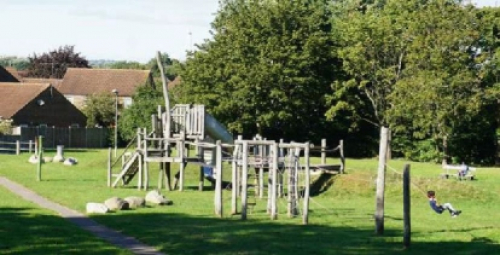
Play spaces should be integrated into the overall site layout and overlooked by development providing natural surveillance and opportunity for independent play
Reason
5.11.7 Facilitating play is essential for children's well-being, both physically and emotionally. The freedom for exploration and creativity enhances learning, problem-solving and interpersonal skills. A variety of play types should be provided, including for example rocking, swinging, climbing, sliding, rotating, swinging and multiplay units that provide imaginative and encourage group play.
5.11.8 On larger developments, major play space should be located in accessible locations, helping to create a hub of activity, community focus and ensuring facilities are sustained.
5.11.9 Applicants should liaise with the council's planning, parks and landscape teams at an early stage of the design process, before the locations of play spaces have been decided to seek guidance on integrating facilities within the proposed development.
5.11.10 A robust palette of materials and textures should be used which meets the functional, environmental and adoption requirements of the play space as well as the character of the area. Where timber equipment is considered appropriate, it should have a minimum 15-year warranty and metal footings should be used to increase longevity of the equipment.
Principle DES35: Enhance the environment and sense of place through tree planting and soft landscape
Applicants should recognise the importance of tree planting and soft landscapes in creating and adding to an area's sense of place and legibility, by providing a landscape strategy for proposed development and how this integrates with the green infrastructure of the wider area. Wherever possible effort should be made to retain high value trees especially where opportunities for new planting are limited
Species selection should take into account the local species of the area, in combination with design objectives and assessing species suitability in relation to climate change, pest and disease tolerance and prevailing environmental conditions, such as soil type and drainage. Use of native species is desirable in development adjacent to the open countryside as they are locally distinctive and help to provide continuity in habitats.
Planting designs should have a clear objective, theme and aims with the level of formality and enclosure defined. Formal tree planting and tree species that grow to a larger size should be provided on main streets and at key junctions to reinforce their importance in the street hierarchy and provide landmarks. Seasonality within the Vale should be reflected in the areat's public realm planting, rather than adopting standard planting combinations.
Applicants should consider incorporating edible landscapes, to reflect the importance of orchards in the Vale for their landscape and habitat value.
Applicants should seek expert advice from the appropriate professionals (landscape architects, horticulturalists, arboriculturists and ecologists) to help inform planting design, selection, establishment and management. Design schemes should be accompanied by an Arboricultural Impact Assessment in accordance with BS5837. The cost of management and maintenance should be considered, and adequate funding provided.
The proposed planting palette, future maintenance and management should be discussed and agreed with the council prior to submission of an application.

Figure 5.34: The benefits of tree planting and soft landscaping
Reason
5.11.11 Tree planting is a vital part of enhancing existing and developing new character and sense of place. From the outset of open space design, the nature of a landscape and how it matures should be considered, particularly in relation to ultimate size, lifespan and maintenance requirements of plants and trees.
5.11.12 Retaining, improving and connecting existing trees, hedgerows and vegetation as part of the design of the development should be prioritised as new planting may take many years to realise its full suite of benefits.
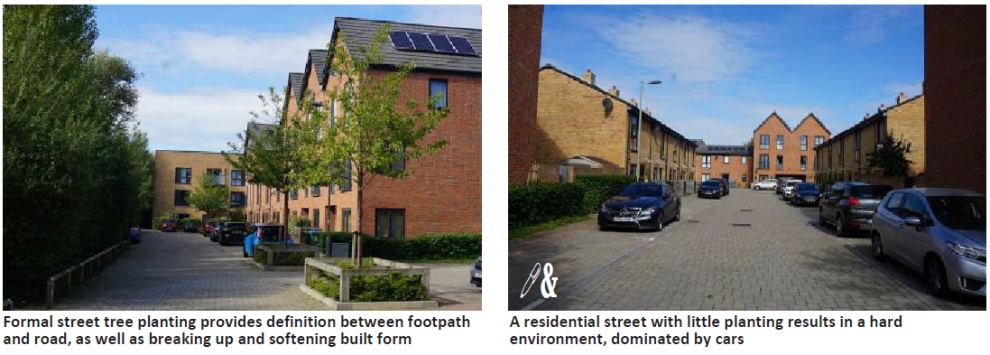
5.11.13 The multi-functional benefits of trees and vegetation include aesthetic value, visual screening, shelter, recreation, cultural significance, CO2 absorption, cooling properties, pollutant removal, improving air quality, reducing surface run-off and habitat value. Maintenance regimes of trees and vegetation should be relaxed where appropriate to encourage greater structural diversity and increase the number of species niches.
5.11.13 Planting design and species selection should take the landscape context into account and emphasise 'the right tree, right place' approach whilst not adversely impacting on biodiversity.
5.11.14 New planting proposals should take account of the full design life of the development. Generally, larger trees should be used when space permits and short-lived species should be avoided. Developments should aim to maintain or increase vegetation canopy cover on a site.
5.11.15 If tree and vegetation removal is required as part of the development, then replacement planting should compensate for its loss and wider value in terms of size, quality, amenity and species.
5.11.16 Applicants should consider environmental issues that affect trees and vegetation, including climate change and biosecurity. This could include the use of different cultivars which are more appropriately adapted to warmer conditions or more tolerant to pests and disease.
5.11.17 To ensure tree planting is future-proofed best practice guidance should be followed including 'BS 8545:2014 Trees: from nursery to independence in the landscape' and Trees and Design Action Group 'Trees in Hard Landscapes: A Guide for Delivery'.
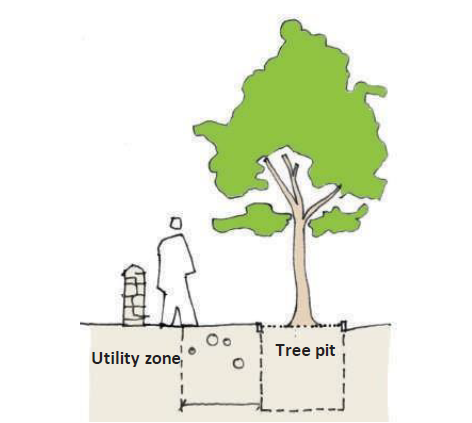
Figure 5.35: Professionally designed tree pits should be used to provide the necessary soil volume required to successfully establish the tree. Tree pit design needs to consider any adjacent service runs and particular care is needed for trees in hard surfaces
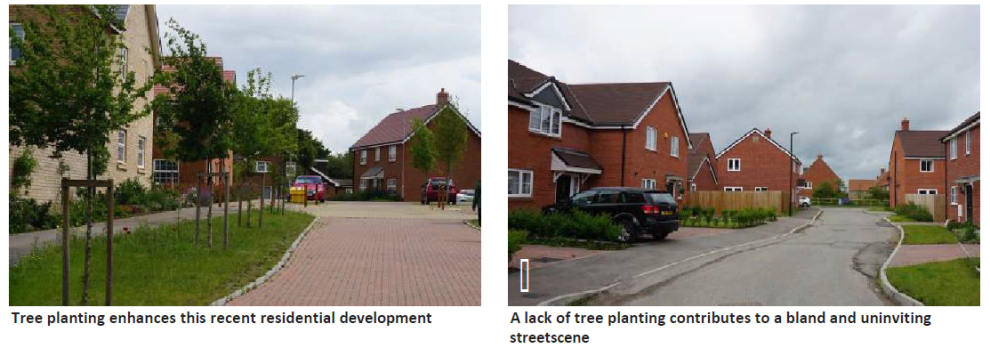
5.11.18 Whilst creating tree avenues and blocks of a single species helps to deliver character and legibility, applicants should avoid large numbers of the same species to safeguard against the risk of tree losses through climate change, pest and disease. Species with similar characteristics can be selected to create similar effects as single species planting, or species changed by street, which is preferred. Modern approaches to planting should also be used, including structural tree pits, rooting break out spaces and root barriers to provide the best environment for tree establishment, health and longevity, and to protect pavements, other surfaces and utilities.
5.11.19 The following broad themes for new planting should be considered:
- Aylesbury: a bold and distinctive pattern of new planting has begun to develop along major roads, further enhancing distinctiveness. Open spaces on the edges Aylesbury should aim to increase the proportion of native species, and major parks should use distinctive species which are appropriate to the conditions and existing context of the park. The town centre should use specimen trees or formal groups where space allows.
- Riversidesandwatercourses:use native riparian species, in particular consider using the locally distinctive and nationally rare Black Poplar.
- Rural locations adjacent to the countryside: use native species unless special circumstances favour mixed species planting.
5.11.20 When designing soft landscape (planting) the following factors should be considered:
- The existing character and context of the area;
- The character and function of the proposed development, whether it will be formal or informal;
- Whether the planting aims to enhance local distinctiveness;
- The space available for growth above and below ground;
- Final anticipated shape of plant or tree, including height and spread;
- How the soft landscaping will change throughout the seasons, and whether this could have an impact on its function i.e. screening views;
- The tree strategy in conjunction with existing and new services both underground and overhead. Well considered tree pit design can successfully function alongside services, seek advice from specialists where necessary; and
- How growth will affect natural surveillance of public realm or open space and whether maintaining surveillance requires high maintenance regimes.
Principle DES36: Deliver a high quality, coordinated and attractive public realm that is easy to manage and maintain
Public realm (the streets and spaces around buildings) should be designed and maintained to a high standard, using a robust, sympathetic and locally distinctive palette of materials with limited clutter.
Historic elements of the public realm, the street surfacing, street furniture, lighting and the historic buildings and features that enclose them including shopfronts, are a valuable asset and contribute strongly to an area's historic character and sense of place. These features should be protected and maintained, where they survive, and used as the starting point for designing the public realm around them.
Materials which complement the surrounding context of the Vale should be used (see 3.3 Landscape character and 3.5 Settlement character). Natural stone either as flags, setts or cobbles or brick may be the most appropriate, particularly in historic and rural locations. Concrete or tarmac should be used with care as their uniform appearance and sharp finish can detract from the character of a new development.
Public art should be integrated into the public realm to create a focal point of incidental joy and richness to reflect heritage and culture and can be created with community engagement.
Lighting and street furniture should be robust, functional and high quality. The importance of reducing street clutter should be recognised by the applicant, and therefore functions should be combined when possible, for example retaining walls with benches, or lighting columns with signage. Consideration should also be given to the mounting of street lighting or street name plates on buildings to remove the need for unnecessary columns. Lighting should be carefully designed to be low energy and take account of areas of sensitive habitat or locations defined as having dark skies.
The location of new and existing utilities should be considered at the beginning of the design process, with every effort being made to facilitate easy access and limitation of damage to trees. Underground utilities should be aligned with paths and not interfere with soft landscape areas.
The proposed palette of materials and furniture should be coordinated with the surrounding context, discussed and agreed with the council prior to submission of an application and consideration given to long term maintenance and management.
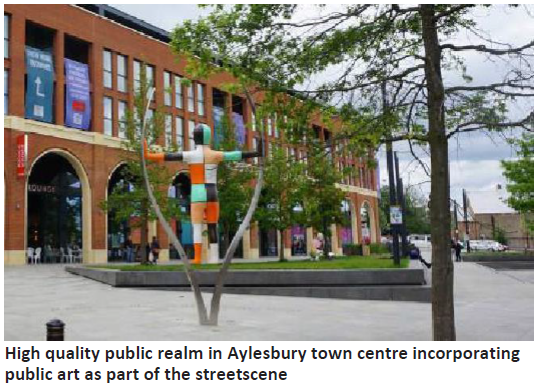
Reason
5.11.21 Alongside its buildings, a settlement's public realm is the most important aspect of development for reflecting local character and context, People's experience and perception of a place is often defined by the public realm, forming the stage for community cohesion and engagement.
5.11.22 There are many elements that contribute to a successful public realm, including: permeable and legible spaces that are welcoming, easy to use and maintain, the use of high-quality materials in a simple palette to complement the existing context, well detailed hard and soft landscape that is long-lasting, varied and well- maintained , tree planting, and the inclusion of public art.
5.11.23 Public realm schemes often work well when they are first completed but if they are not easy to maintain or if replacement materials are expensive or difficult to obtain then their quality can rapidly diminish. Careful thought must therefore be given to management and maintenance from the outset.
Public realm quality

Left: Planting can transform the public realm but consideration must be given to maintenance. Centre: A coordinated materials palette is important in public realm design. Right: High quality palette of materials complements historic setting

Left: Trees and artwork can provide shelter. Centre: Lighting can transform a space at night. Right: Public spaces provide opportunity for relaxation and social interaction.

Left: Seating allows people to enjoy a public space. Centre: Public spaces may form the setting for entertainment. Right: USB charging points discretely designed into the public realm provide an additional attraction.
How to use
This table provides a checklist for use by both the applicant and planning officer to check that appropriate consideration has been given to how an application has addressed the site layout, streets and spaces.
PROCESS: Have you read, understood and applied the principles set out above?
The adjacent table summarises the key principles set out within this chapter and can be used by the applicant and officer as a checklist.
Applicants will be expected to demonstrate to the council that they have responding adequately to all relevant principles in preparing their proposals, or provide a justification for any failure to do so.
|
PRINCIPLE |
DESCRIPTION |
CHECK |
|
DES18: Inclusive design |
Has the applicant demonstrated that the principles of inclusive design has been considered and incorporated within the design from the outset? |
|
|
DES19: Urban structure |
Does the design provide a clear street hierarchy and network of open spaces? |
|
|
Does the design create a grid network of streets and perimeter blocks? |
||
|
Do development blocks take account of natural features orientation and topography? |
||
|
DES20: Enclosure |
Does the design provide enclosure of street space and continuous frontages with corners of blocks appropriately emphasised? |
|
|
Does the proposal provide a sense of enclosure appropriate to the street hierarchy and achieve a human scale? |
||
|
DES21: Mixof uses |
Does the proposal provide a mix of uses conveniently located to meet local needs? (where appropriate) |
|
|
Are these uses located where they are easily accessible and visible to attract custom? |
||
|
Are servicing areas designed so that they do not visually dominate the streetscene? |
||
|
Is adequate cycle and car parking provided and in a convenient location? |
||
|
DES22: Residential mix |
Does the proposal provide a mix of residential dwelling types and tenures to meet local need? |
|
|
Are affordable homes 'pepper-potted' throughout the site, and have the same external appearance and quality of finishes as private housing? |
||
|
Are buildings designed so that they can be altered internally or externally over time without the need for demolition or rebuilding as needs change? |
||
|
DES23: Density, scale and massing |
Does the proposal respond to the scale, height and massing of its context? |
|
|
If it is at a greater density is this adequately justified? |
||
|
DES24: Legibility, landmarks and vistas |
Does the structure or layout of the proposed development appear easy to navigate and easy to understand? |
|
|
Has the applicant demonstrated how the use of landmarks, marker buildings and vistas has informed the proposal? |
||
|
DES25:The development edge |
Has the applicant (where applicable) demonstrated how their proposals provides a positive edge with building frontages facing site boundaries served by roads that run adjacent to the site edge? |
|
|
Has the applicant (where applicable) demonstrated a sensitive response to the rural edge? This will normally require less density and additional soft landscaping along the boundary. |
|
PRINCIPLE |
DESCRIPTION |
CHECK |
|
DES26: Pedestrian friendly streets |
Are the proposals designed as social spaces with the needs of pedestrians, cyclists and public transport users put above the needs of the motorist? |
|
|
Is the street environment designed to encourage pedestrian movement through appropriate pavement widths, avoiding unnecessary barriers or clutter and providing places for pedestrians to rest, gather and socialise. |
||
|
Are the proposed pedestrian and cycling routes accessible to all members of the community? |
||
|
Are traffic calming measures integrated within the design of the streets? |
||
|
Has provision been made for pedestrians and cyclists to cross busier roads, e.g. formal crossing facilities or underpasses? |
||
|
DES27:Carparking |
Is parking for both residents and visitors proposed at an adequate level in response to the location of the site and in locations that safeguard the quality of the street environment? |
|
|
Is the parking provision in line with council parking standards? |
||
|
Have electric charging points been incorporated into the proposals? (sites of >10 homes) |
||
|
DES28:Planfor cyclists |
Does the proposal contribute positively to the network of cycling routes in the area? |
|
|
Does the design provide adequate cycle parking in suitable locations for both public and private users? |
||
|
Does the design include for secure and convenient storage of bicycles in residential dwellings? |
||
|
DES29: Commercialareas and infrastructure |
Has the layout of employment areas or infrastructure (where appropriate) been designed taking a landscape led approach that minimises visual intrusion and responds to the landscape character and form. |
|
|
Is the layout of employment areas configured to provide links to natural assets, creates open spaces for workers and minimise the impact of car parking and servicing? |
||
|
DES30-32: Refuse, storage and utilities |
Has the layout of development been designed to facilitate service vehicles and refuse collections? |
|
|
Are sub-stations and pump stations carefully designed and integrated into development so that they do not detract from the quality of streets and public spaces? |
||
|
Are utility runs located where they do not impact on the potential for street tree planting? |
||
|
Are refuse and recycling facilities conveniently located and unobtrusive |
|
PRINCIPLE |
DESCRIPTION |
CHECK |
|
DES33:Openspace |
Does the design link existing and proposed landscapes and open spaces to form green infrastructure networks and contribute and respond to the hierarchy of existing open spaces? |
|
|
Are all spaces designed with a specific role or function to avoid residual, unused or neglected spaces? |
||
|
Has consideration been given to the long-term management and maintenance of open space and public realm? |
||
|
DES34:Playspace |
Does the provision of open space meet the standards set out in the AVDC Assessment of Open Space, Sports and Recreation Needs for Aylesbury Vale (or replacement documents)? |
|
|
Is the play provision integrated into the design of the development where it is overlooked? |
||
|
DES35:Treesand soft landscape |
Does the design of the planting demonstrate clear objectives that respond to the place? |
|
|
Has an understanding of the existing habitats (e.g. trees, hedgerows and woodlands) informed the design? |
||
|
Has tree planting and soft landscape been provided within street designs? Are tree species appropriate for their location and to the nature and hierarchy of the street? |
||
|
Has the applicant demonstrated that the species selected are appropriate for the location? |
||
|
Has the applicant demonstrated that the long-term maintenance and management of landscape elements have been considered to ensure their successful establishment? |
||
|
DES36:Publicrealm |
Has a suitable palette of high quality materials been proposed that responds to the character of the place as identified in the Character Study? |
|
|
Has the selection of street furniture been restricted to essential items and have functions been combined where possible? |
||
|
Is the street furniture simple, high quality, well designed, robust and responsive to its setting? |
||
|
Has a lighting strategy been proposed that: minimises the impact of lighting columns on the streets; accords with the design approach to other street furniture and avoids causing light pollution particularly in sensitive and dark rural areas? |
||
|
Has the location, design and integration of utilities within the landscape been considered to mitigate their impact on the public realm? |
||
|
Has the provision of public art been considered? |





